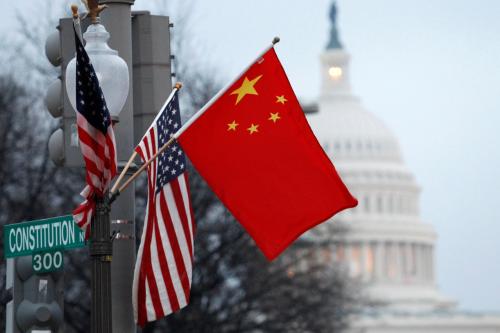What is the international destiny of the reminbi (China’s currency, also known as the RMB or yuan)? Will RMB internationalization—that is, wider use of the RMB in international economic transactions—integrate with the existing liberal international monetary order? Does the RMB have the potential to achieve the status of a hegemon, replacing the dollar in the global currency hierarchy?
These questions will not be answered in the near future. In the near term, despite growing skepticism about the dollar’s global role, the RMB is unlikely to significantly challenge—much less replace—the U.S. dollar. Several political factors will continue to hinder the RMB from becoming the globally dominant convertible currency in the foreseeable future. They include China’s lack of hegemonic power, weak non-state actors, normative fragmentation, absence of security alliances, and the Hong Kong crisis. These factors may conspire to constrain the greater international use of the RMB even though China is on the rise.[1]
Over the past few years, Chinese leaders have proclaimed RMB internationalization as a key component of China’s financial statecraft, and the People’s Bank of China and other government agencies have successfully implemented a series of policy initiatives. The use of the RMB in trade settlement has been considerably expanding. One can argue that a rising great power with growing international political ambitions will inevitably seek to enhance the influence of its currency abroad. Powerful states such as Britain, France, Nazi Germany, imperial Japan and the United States have routinely sought to encourage the international use of their currencies in order to achieve the greater freedom of action and increased political influence.[2] In this sense, China’s monetary ambition is neither unique nor infeasible. However, economic size (or growing economic power) alone does not appear to be enough to make the RMB competitive any time soon. China needs to cope with the following political challenges to achieve its monetary ambition.
Hegemon status
In the current international monetary system, China falls short of achieving the status of a hegemon, one that was enjoyed by the United States even before the emergence of offshore dollar (or Euro dollar) markets during the early postwar period. Despite its rapidly growing economic muscle, China is still not capable of setting a new global standard and revising existing institutions on its own. China also lacks structural power in global finance, a power that can come from a high degree of depth and liquidity in the Chinese financial market, which is key to attracting global financial business. The (albeit weakening) dominance of the U.S. dollar as a key international currency today naturally limits the attractiveness of RMB holdings to foreigners. However, this does not mean that China cannot develop and use a kind of market-based power in global finance in the long run. The relative size of the Chinese economy and growing foreign reserves may enable Beijing to pressure its trade partners in the region to use the RMB to finance their trade with China. Nevertheless, the dollar-centered global currency system will continue to constrain the scope and pace of the international use of the RMB in the near future.
Weak non-state actors
One can note the relatively weak influence on Chinese policy making of societal or private business groups who are supportive of financial liberalization and opening. On the other hand, the state-owned business elites are closely aligned with the party-state. Politically powerful state-owned enterprises (SOEs) and state-controlled banks tend to resist full RMB internationalization and rapid financial liberalization because they would undermine the control over policy and finance that has been crucial for China’s investment-driven, export-led development model. There is a liberal-conservative division within the party-state regarding the scope and pace of financial reforms, and more power rests with government agencies that ally with SOEs. The liberal group is represented by the People’s Bank of China (PBOC), which appears to use RMB internationalization as a means to push forward with domestic financial and monetary reform.[3] The conservatives come from the Ministry of Finance, the National Development and Reform Commission (NDRC), and the State Asset Supervision and Administration Commission (SASAC). The conservatives caution against prioritizing RMB internationalization and capital account liberalization over other national development programs and strategies. They believe that China’s comparative advantage still lies in labor mobilization within the traditional manufacturing sector, not in the financial sector. The PBOC has less political clout than other ministries, and recently it has lost battles on key monetary policies. Powerful SOEs and their governmental allies stand to gain from the current financial system and have a huge stake in state-led development even though the Chinese leadership has expressed its political willingness to reform the Chinese economy. China’s path to RMB internationalization may reflect the nature of state capitalism that is characterized by increased yet limited use of the market mechanism combined with state ownership and control of the most strategic sectors of the economy.
Normative fragmentation
One may also find that RMB internationalization has occurred within a changing normative structure at the international level. In the 1970s, prevailing international norms that supported capital controls eroded and were replaced in subsequent decades by the market-oriented ideas of financial liberalization—namely, the “Washington consensus.” In the 21st century, however, such hegemonic neoliberal ideas appear to have declined, and normative fragmentation (or the absence of a new global consensus) on global financial governance seems to hold sway.[4]
Normative fragmentation driven by international financial crises (especially the recent global financial crisis) has reinforced Chinese skepticism about the Washington-knows-all (or universal) approach and heightened appreciation of China’s own development model wherein China puts domestic economic and social goals ahead of an open global economy and currency internationalization. Beijing takes the view that a national economy needs active management to ensure full employment and proper growth. This requires Chinese policymakers to have sufficient autonomy or distance from the volatile international financial market, to conduct monetary and fiscal policy while implementing financial liberalization and opening in a highly cautious and slow manner. The changing normative structure is more likely to discourage or slow down China’s one-way assimilation into the American-centered liberal monetary order.
Security alliance system
The absence of formal alliances also seems to constrain the scope of China’s political leverage to internationalize its currency. The dollar internationalization of the early postwar years was supported not only by the United States but also by key Western European allies[5] – China does not enjoy such support as it pursues RMB internationalization. The Cold War period gave U.S. allies more political incentives to maintain economic and financial ties with the United States through the offshore dollar market. With political confidence and trust, London banks started to lend out Eurodollars to other corporate customers in Western Europe in the 1970s.
However, a rising China to date has eschewed pursuing and developing any strong formal military alliance system. Rather, the recent assertive turn in China’s international behavior in the East and South China Seas appears to have strengthened the perception of a “China threat” across the region. For China’s neighbors, there are political risks associated with deepening economic and financial integration with a more aggressive China, as Beijing may threaten to exploit its increased economic leverage. Especially in East Asia, where the legacies of war, (semi)-colonialism, and communism have generated suspicion and antagonism toward regional hegemony, security considerations would require China to make some extra efforts to promote the acceptance of the RMB.[6]
Hong Kong crisis
The recent, and still unresolved, Hong Kong crisis may undermine the critical role of Hong Kong as a testing ground for evaluating the impact of possible RMB convertibility and capital account liberalization. These qualities are prerequisites for full-fledged RMB internationalization. RMB internationalization has adopted an experiment-based method; that is, first gaining experience in a small number of selected sites and then spreading the local experiences to larger arenas. This policy experimentation has been a consistent element of China’s post-Mao reforms in a variety of issue areas including private business restructuring, state-owned enterprise reforms, and rural de-collectivization. Hong Kong’s role as a laboratory for offshore RMB transactions began in 2004, providing RMB to the rest of the world by allowing foreign financial institutions to tap offshore RMB. However, protracted protests and political stalemate can damage the Hong Kong’s political and economic stability and threaten its status as a key international financial center. Shanghai and other Chinese cities lag far behind Hong Kong in terms of financial market development and cannot easily replace Hong Kong as a key laboratory for the advanced level of RMB internationalization, but a growing sense of uncertainty about the future of Hong Kong will not create a favorable environment for more ambitious policy experiments with RMB internationalization. Moreover, Beijing’s inflexible response to Hong Kong’s aspiration for more free and open elections can hardly inspire confidence in the Chinese government among international users of the RMB. If international market operators are to invest significant amounts of their wealth in the Chinese currency, they will want reassurance that the arbitrary action by the RMB issuer should be restrained. Rule of law and checks on the government are important sources of such assurance.[7] However, the Chinese party-state is not known for transparency in decision-making and often exhibits seemingly arbitrary behavior. Significant political reform is necessary to encourage wider international use of the RMB, but this is not an easy step for current Chinese leadership.
In sum, in addition to economic obstacles that are not addressed here, China faces substantial political hurdles that may dictate a slow path to full RMB internationalization. They are not insurmountable obstacles, but would undoubtedly entail bold, painful and far-sighted policy adjustments by Beijing. Given such daunting challenges, the RMB is not likely to become a globally convertible dominant currency in the foreseeable future―though it might be reasonable to conjecture that the RMB will encroach on the dollar and become a dominant currency in East Asia unless the Chinese economy hits a major bump or a serious political crisis happens (a possibility not to be completely dismissed). Such a trend may contribute to the possible emergence of what Benjamin J. Cohen called “an increasingly leaderless mix of currency relationships” in the post-global crisis world.[8]
Editor’s Note: This commentary is adapted from the author’s forthcoming article in the Korean Journal of International Studies (April 2015).
[1] This article does not address economic obstacles to full RMB internationalization since the existing literature has already discussed them in some detail.
[2] Kirshner, Jonathan. 2014. “Regional Hegemony and an Emerging RMB Zone.” In Eric Helleiner and Jonathan Kirshner (eds.), The Great Wall of Money, Ithaca, NY: Cornell University Press, 213-240.
[3] Volz, Ulrich. 2012. “Prospects of the Reminbi to Become a Global Currency.” Paper presented for a workshop on financial statecraft at University of Southern California (July 28).
[4] Sohn, Injoo. 2012. “Toward Normative Fragmentation: An East Asian Financial Architecture in the Post-Global Crisis World.” Review of International Political Economy 19-4 (October).
[5] Helleiner, Eric. 1994. States and the Reemergence of Global Finance. Ithaca, NY: Cornell University Press.
[6] Chen, Xiaoli and Yin-Wong Cheung. 2011.“Renminbi Going Global.” HKIMR Working Paper No 08/2011(March).
[7] Cohen, Benjamin J. 2012. “The Yuan Tomorrow? Evaluating China’s Currency Internationalization Strategy.” Working paper. Accessed at http://polsci.ucsb.edu/faculty/cohen/working/pdfs/NPE.pdf (November 10, 2013).
[8] Cohen, Benjamin J. 2009. “Toward a Leaderless Currency System.” In Eric Helleiner and Jonathan Kirshner eds., The Future of the Dollar, Ithaca, NY: Cornell University Press, 142–63.
The Brookings Institution is committed to quality, independence, and impact.
We are supported by a diverse array of funders. In line with our values and policies, each Brookings publication represents the sole views of its author(s).



Commentary
Op-edFive political challenges in China’s monetary ambition
March 9, 2015